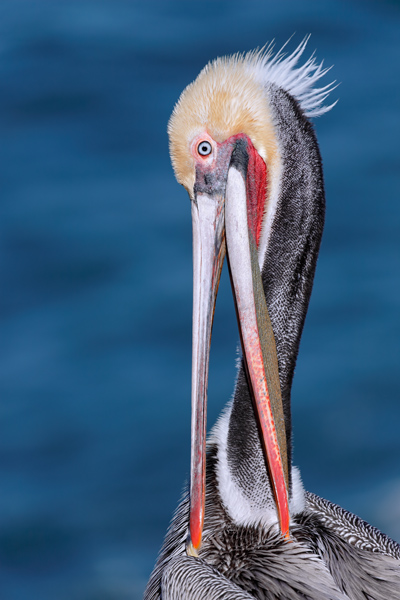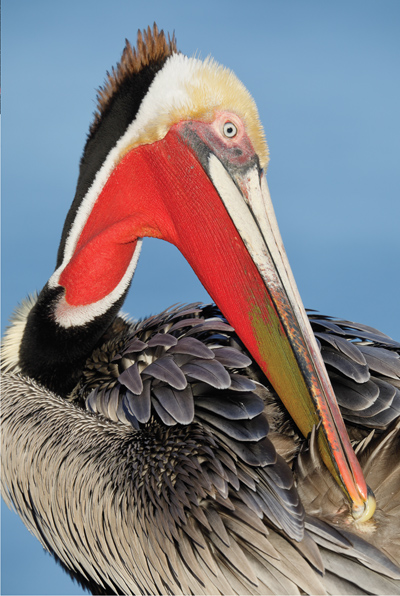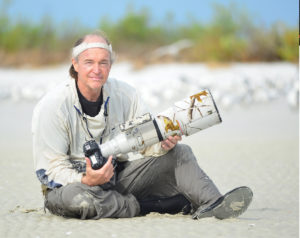
by Arthur Morris
In the late 1960’s, my parents moved from Brooklyn, New York, to North Park, California, near San Diego. For several years, I carried golf clubs when visiting them but by the late 1970’s I began “birding” and brought binoculars instead. In August of 1983 I purchased my first telephoto lens and the rest became history.
 Each year since 1990, I have visited San Diego from late December through mid-February to photograph the Pacific race of Brown Pelican with their incredible bright red and olive green bill pouches. The birds attain this rich soft parts’ coloring in early winter as the breeding season approaches. Pelicans, at the absolute height of breeding plumage, feature rich, dark, chocolate-colored napes (hind-necks). The many birds still in non-breeding plumage sport pure white napes. Many of those feature the bright red bill pouches. Some are neither here nor there; I call the molting pelicans “carpet necks” for the pebbly black and white pattern of feathers on the back of their necks.
Each year since 1990, I have visited San Diego from late December through mid-February to photograph the Pacific race of Brown Pelican with their incredible bright red and olive green bill pouches. The birds attain this rich soft parts’ coloring in early winter as the breeding season approaches. Pelicans, at the absolute height of breeding plumage, feature rich, dark, chocolate-colored napes (hind-necks). The many birds still in non-breeding plumage sport pure white napes. Many of those feature the bright red bill pouches. Some are neither here nor there; I call the molting pelicans “carpet necks” for the pebbly black and white pattern of feathers on the back of their necks.
Photographing the pelicans on the cliffs of La Jolla is great fun, and capturing the action is challenging. Pelican behavior is as interesting as gull behavior; the birds are forever preening, stretching, and scratching; they interact often; they pull their bill pouches down over their breasts to clean them, that often followed by spectacular head throws, the latter thought to be a form of intra-flock communication. If you want to frame a head throw properly, you’d best have a telephoto zoom lens and you’d best be quick and decisive. In addition, there is lots of flight photography.
La Jolla is a hilly, affluent, seaside community about 12 miles north of downtown San Diego via Interstate 5. Harbor Seals can usually be found inside the breakwater at Children’s Cove. Photographic access there can be problematic at times as the city’s position on protecting the seals varies from over-protection to seemingly approving measures designed to drive the federally protected mammals from their favored haunts… California Sea Lions have become more and more common in recent years and can easily be photographed at many La Jolla locations.
 The cliffs south of Children’s Cove can be great for a variety of shorebirds and gulls. The common shorebird species there include Sanderling, Willet, Black-bellied Plover, Spotted, Western, and Least Sandpiper, Wandering Tattler, Black and Ruddy Turnstone, and Surfbird. On a good day you might add and photograph Whimbrel, Marbled Godwit, and Semipalmated Plover. Once, my Instructional Photo-Tour (IPT) group got to photograph both Black and American Oystercatcher together on a single rock. On rare occasion you might find a Snowy Plover anywhere that there is a stretch of sandy beach.
The cliffs south of Children’s Cove can be great for a variety of shorebirds and gulls. The common shorebird species there include Sanderling, Willet, Black-bellied Plover, Spotted, Western, and Least Sandpiper, Wandering Tattler, Black and Ruddy Turnstone, and Surfbird. On a good day you might add and photograph Whimbrel, Marbled Godwit, and Semipalmated Plover. Once, my Instructional Photo-Tour (IPT) group got to photograph both Black and American Oystercatcher together on a single rock. On rare occasion you might find a Snowy Plover anywhere that there is a stretch of sandy beach.
Western, Ring-billed, and Heerman’s Gulls of all ages are common in winter along the La Jolla coast; California Gull in various plumages are regular. The breeding plumage adult Heerman’s Gulls are stunningly beautiful with their shades-of-gray upperparts, pure white heads, and blood red bills. The beach by the Coronado Hotel is great for gulls, too. With a bit of searching, you can usually add Mew Gull.
The creek in the southwest corner of Glorietta Bay not far from the big hotel can be great for Lesser Scaup. On some visits you may get to photograph White-winger Scoter, Common Loon, Redhead, Eared Grebe, and both Western and Clarks Grebes. Long-billed Curlew is possible there at low tide along with the more expected Willets and Marbled Godwits. Do be careful of the deep mud at low tide.
Western, Heerman’s, and Ring-billed Gulls are common on the beach north and south of the Scripps Institution of Oceanography Pier. North of the pier you can find Marbled Godwit, Whimbrel, Willet, Sanderling, and Spotted Sandpiper, best on low tides on sunny afternoons; both the water and the wet sand reflect the golden cliffs of Torrey Pines.
If you make your way to the rock piles north of the pier you will likely encounter Spotted Sandpiper and Black Phoebe. The base of the cliffs, rife with colorful stains from runoff, can make for interesting images.
In late spring you can walk along the cliffs at Torrey Pines State Park and try for the Peregrine Falcons that nest there each year. Bring your patience. I spent an entire week there a few years back to get one very good image.
Santee Lakes Regional Park, less than 20 miles north and east of San Diego, is a great spot in winter for the wild ducks that are fed regularly. In the last few years Wood Ducks have become less and less dependable. Ring-necked Duck and Mallard are common: American Widgeon, Northern Shoveler, and Ruddy Duck are regular. If you are lucky you might get a crack at Redhead, Lesser Scaup, Cinnamon Teal, or Bufflehead. Though the drakes of most species are quite handsome, do not neglect to photograph the more subtly colored and patterned hens.
You should know that the spectacularly beautiful Cinnamon Teal drakes are very shy. Though not true ducks, Pied-billed and Eared Grebes along with American Coots are often willing subjects.
When photographing the ducks, be sure to get low either by working while seated behind your lowered tripod or by lying flat on the ground; your images will be much more intimate than those made while standing; they will look as if you were swimming with the ducks. As many species respond to being fed—the camp store sells bags of scratch (cracked grains)—creating tight head portraits is relatively easy.
Aside from the ducks, there are lots of other avian subjects at Santee Lakes. White Pelicans are common, and though they are usually on the shy side, one will occasionally swim right up to you. There are also Black–crowned Night-Heron, Great and Snowy Egrets, and Great Blue Heron; with luck, you can get them with a large stocked trout in their bills. Other species include Great-tailed Grackle, Western Kingbird, Belted Kingfisher, Brewer’s Blackbird, Audubon’s Warbler, and Anna’s Hummingbird but none are easy to photograph. Keep your eyes peeled for raptors that may include Great Horned Owl in early morning or Red-tailed or Cooper’s Hawk among others during the day.
You can make lots of great images with an intermediate telephoto zoom lens like the Nikon 80-400mm VR II or the Canon 100-400mm II. Lenses in this class are deadly on the pelican cliffs as they allow you to vary your framing and your compositions. And they are great as well at Santee Lakes for the species that approach for food.
I always bring a 500 or 600mm f/4 lens to San Diego and use it often either alone or with a 1.4X or the 2X teleconverter. It is great for the shorebirds, for the shyer ducks, and for creating head portraits or tight abstracts of the pelicans. A 70-200 or a wide angle zoom can be great for creating bird-scapes or a variety of scenic images. I always bring a macro lens as well because there are often lots of flowers in bloom even in winter. My two favorites are the Ice Plant flowers and the larger Bird of Paradise blooms. Find the former along the cliff tops and find the latter almost anywhere.
With its legendary wonderful weather and a plethora of natural history subjects including birds, pinnipeds (seals and their allies), flowers, and scenery, San Diego is an ideal location for a photographic vacation. To learn more about exactly where and when to photograph in and around San Diego check out the BIRDS AS ART San Diego Site Guide. You can purchase a copy of this e-book in the BIRDS AS ART On-line Store here: www.birdsasart-shop.com.
Everyone reading this article should subscribe to Artie’s educational blog at www.BIRDSASART-Blog.com. There you will find a free photographic education most every day of the year. Click on the “BAA IPTs” link on the orange/yellow tool bar at the top of each blog page to learn about BIRDS AS ART Instructional Photo-Tours. Artie leads every trip including at least one to San Diego in January or February of each year. Feel free to e-mail Artie with questions at samandmayasgrandpa@att.net.
 Arthur Morris is widely noted as one of the world’s premier bird photographers and photographic educators. He has been a Canon Explorer of Light for more than two decades. He is the author of “The Art of Bird Photography” (more than 45,000 sold) and “The Art of Bird Photography II” (ABP II-916 pages, 900+ images, on CD only). About two-dozen of his images have been honored in the world’s most prestigious photographic competitions including the BBC Wildlife Photographer of the Year Competition and the Nature’s Best Contest.
Arthur Morris is widely noted as one of the world’s premier bird photographers and photographic educators. He has been a Canon Explorer of Light for more than two decades. He is the author of “The Art of Bird Photography” (more than 45,000 sold) and “The Art of Bird Photography II” (ABP II-916 pages, 900+ images, on CD only). About two-dozen of his images have been honored in the world’s most prestigious photographic competitions including the BBC Wildlife Photographer of the Year Competition and the Nature’s Best Contest.










